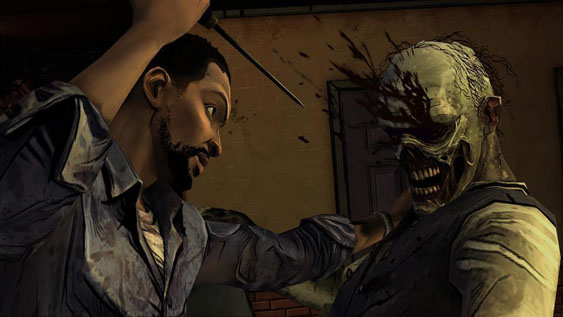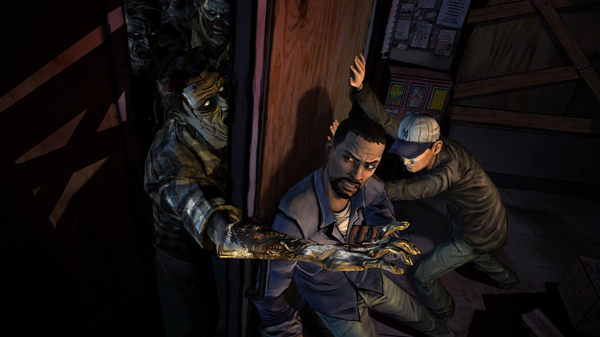Kiddies… avert your eyes.
The year is 1968 and George A. Romero has unleashed his ground-breaking masterpiece,  Night of the Living Dead. It is the first in a long line of films which will shape the zombie genre as we know it today.
Fastforward to the year 2003 and Robert Kirkman has released the first issue of a monthly black-and-white comic book titled The Walking Dead. It follows the exploits of a band of survivors in the wake of a zombie apocalypse and offers a fresh spin on a genre which has been content to offer retreads of its well-established conventions. Kirkman’s world is a horrifying place. It’s a world where society has crumbled and fragile concepts such as humanity have become increasingly irrelevant. It’s a world where zombies are the least of your worries.
Following in the wake of the popular television adaptation is this effort from Telltale Games. Like their recent output, it’s an adventure game which plays more like The Secret of Monkey Island than Valve’s Left 4 Dead. It unfolds over five episodes and tells the story of Lee, a man who has been convicted of murdering his wife’s lover. The writers have done an excellent job in crafting an engaging story which captures the tone of the source material perfectly. Though dark, the script offers moments of levity sprinkled throughout the game. This is made possible by some of the best voice-acting in a video game. From the guilt-ridden inflections of Lee to the bouncy optimism of Clementine… every line is brilliantly delivered. This elevates the good script and serves to bring Kirkman’s world to life. However, be warned that due to the game’s episodic nature, the game ends on a cliffhanger setting things up for Episode 2.
Fan-fave characters make appearances in Episode 1.
The Walking Dead pays homage to its comic book origins by opting for a cell-shaded aesthetic. This art style makes for a more vibrant look and helps to inject some added personality to the game. Likewise, the character designs are clean and functional, echoing the minimalist approach of Charlie Adlard’s artwork in the comics. Unfortunately, animation is a mixed bag.
While facial animation is generally well done, other aspects such as walking just aren’t up to par. Human characters move in a stiff and unrealistic manner,  ironically resembling the gait of a zombie.  It’s disappointing that the animation work lacks the polish found in Telltale’s earlier titles such as the Back to the Future games.
The biggest issue with The Walking Dead is the clunky and unresponsive controls. Input lag makes controlling Lee more fussy than it should be and can prove frustrating when you’re trying to walk up to a small object in the background. Thankfully, adventure games typically don’t feature twitch-reflex gameplay and you’re seldomly  penalised for the game’s poor controls.
With the recent explosion of zombie-related media, there’s never been a better time to bash in the brains of the undead. The Walking Dead is a good extension of Robert Kirkman’s vision and fans of classic point-and-click adventures should definitely give it a shot.
[UPDATE] As opposed to penning individual articles for each of the episodes, I’ll update this review upon the release of each new instalment. This will give you readers a more coherent and comprehensive take, whilst allowing everyone to experience the review in chapters. Just like the game!So… on to Episode 2: Starved for Help.
After a delay, Telltale has finally released the second episode in this promising series. The game picks up immediately where it left off at the end of Episode 1, with the cast of characters still holed up in their new base of operations. As is always the case in the world of The Walking Dead, things soon go from bad to flat-out nightmarish. Starved for Help further demonstrates the developer’s understanding of what makes the source material work. It’s a narrative journey designed to connect with the gamer, swirling emotions inside of you till you’re all but spent by the time the credits roll. Like the last episode, this is a game driven by plot and character development, especially smart game design choices given the role these elements have played in the source material’s success.
Unfortunately, the second episode falls prey to the same issues faced in the opening chapter. Odd clipping issues and a choppy frame-rate returns to mar the experience. There’s a sense that so much time was spent on polishing the story, there just wasn’t enough time to afford the technical aspects some much needed care and attention.
Two episodes in and it’s fast becoming clear that The Walking Dead is shaping up to be one of the gems of 2012. Hopefully, there won’t be any delays with Episode 3.




